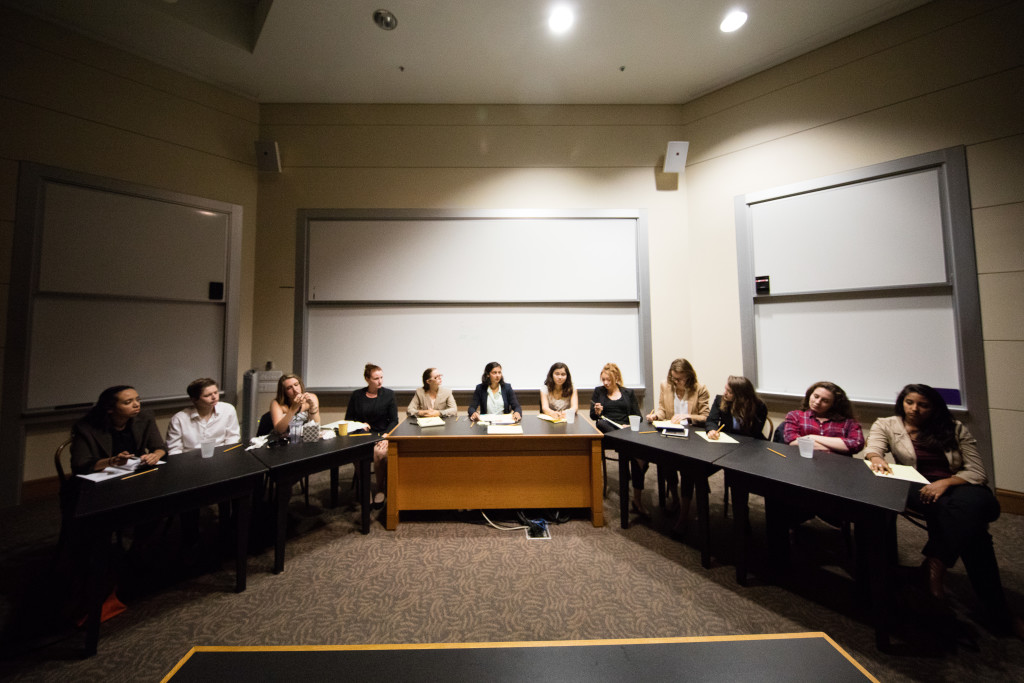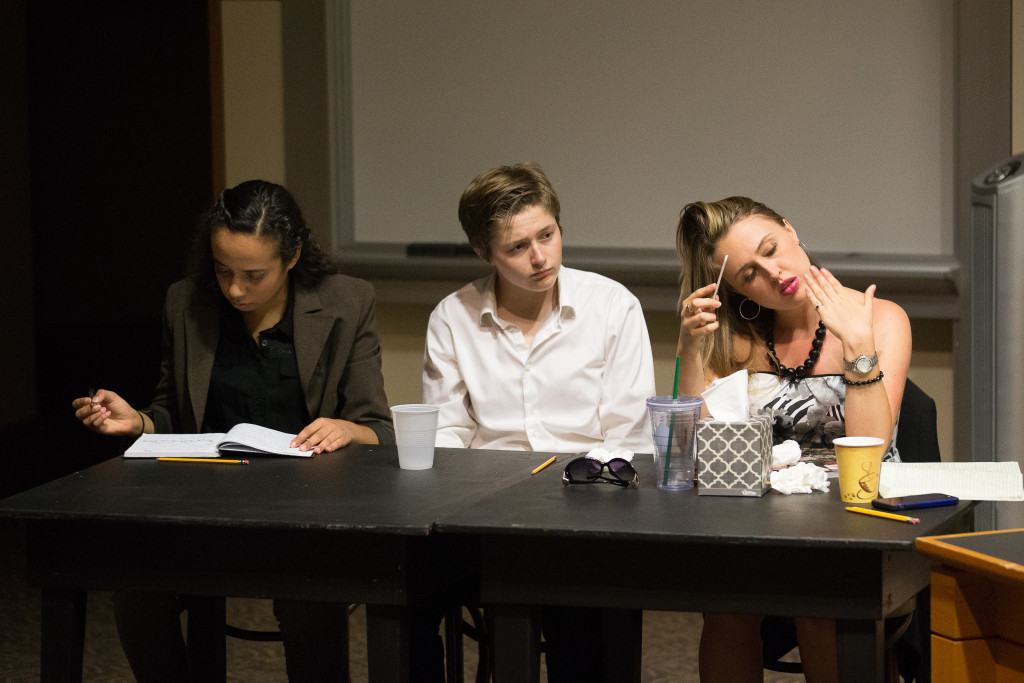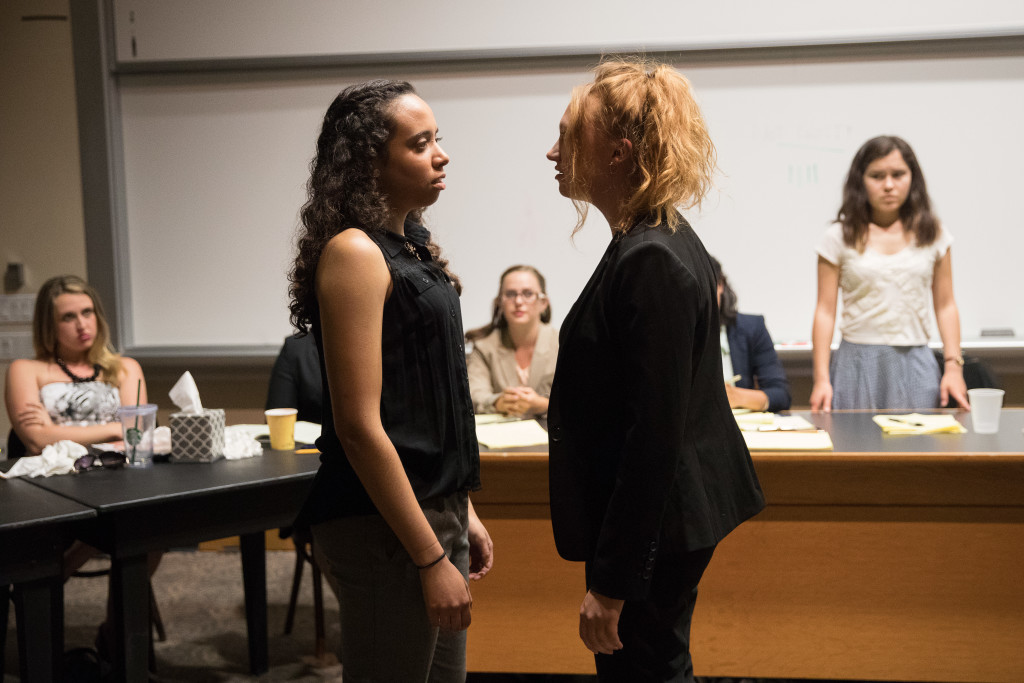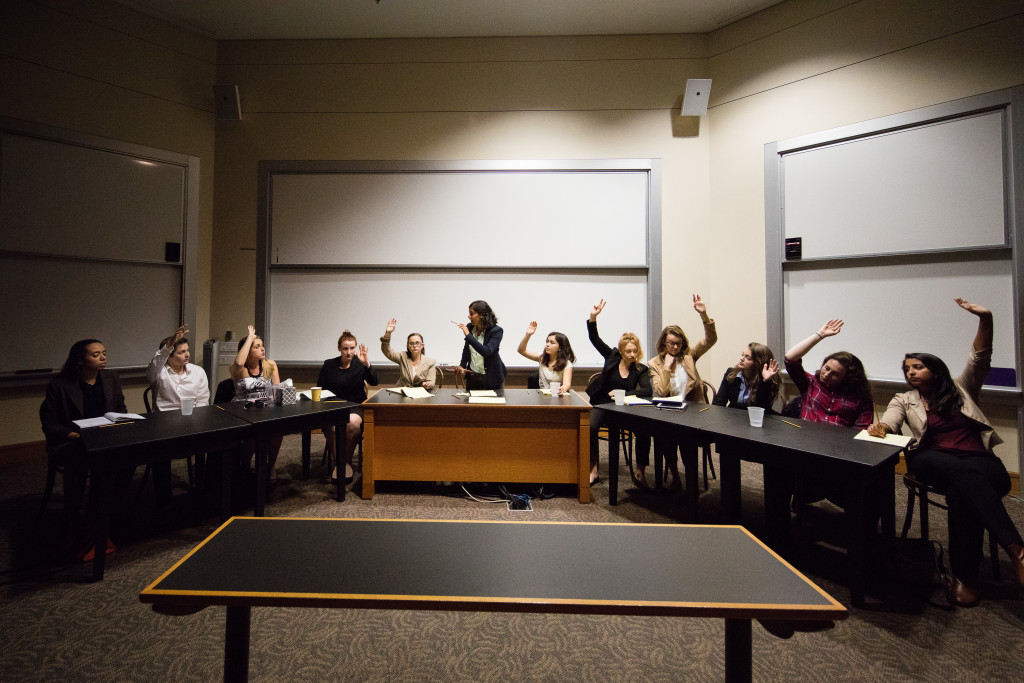
Those lucky enough to have reserved a seat in the symbolically resonant law school lecture hall for the Women* in Theater production of 12 Angry Men — featuring an entirely non-male-identified cast — will certainly not be disappointed. The play itself is a masterpiece, skewering the notion of jury impartiality in criminal proceedings and feeling more relevant than ever in this era of Serial and Making a Murderer. Directors Liz Knarr (’16) and Alison Valentine (’16) take this complex work and compound its nuance by reversing the traditional casting practice of casting all men, a choice which gives the production greater impact at nearly every turn.
The twelve actors enter and sit at a long table, before reshuffling to sit in order of juror number. Uniform seating around this table becomes the default, an official manifestation of the order and due process that are meant to be housed in this room, so that every time anyone as much as stands up, the effect is dramatic.
This play grips you. Like the jury, you are stuck in the room until a unanimous verdict is reached: is the 16-year-old boy guilty of killing his father or not? It’s like a twisted party game: would you rather send a possibly innocent teenager to his death by electric chair or let a possibly guilty murderer walk the streets?
Yet even devoid of scene breaks or transitions (aside from one intermission), the show is paced to perfection. Much of the action happens at the table, or at least, that’s where the facts of the case are revealed. But when tensions start to rise, harried Juror #1 (Shalmali Bane, ’16), a reluctant Jesus at a table of unwilling disciples, suggests a 5-minute break.

These breaks from deliberation punctuate the play, splintering the narrative progression of the case, the unified stage picture, and even the collective noun “jury.” Here we get further glimpses into the characters, anonymous to us save their juror numbers. They define the space, with Bane and Gianna Clark, ’19 (Juror #8) staring convincingly out a window that is in reality a set of stairs leading to the back of the room. They banter, and while we may be listening to the chit-chat between Clark and Heather Connelly, ’18 (Juror #6), we’re watching Juror #7 (Kayla Guillory, ’18) snap a selfie (#juryduty!) with Juror #10 (Johanna Brady, ’16).
What the characters lack in names, they more than make up for in personality. They portray a wide and colorful array of female identities, from Guillory’s sports fanatic to Charlotte Dubach-Reinhold’s (’19) Eastern European Juror #11, who raises questions about what the role of American identity means in the legal system. (“He don’t even speak good English!” Brady complains of the defendant. “He…doesn’t even speak good English?” ventures Dubach-Reinhold). Bella Wilcox (’19) is charmingly earnest as Juror #2, pleased as punch with herself for having a watch with a second hand when one is requested. Alex Scott (’16), as Juror #4, commits wholeheartedly to her marvelous mansplaining, while Noemi Berkowitz’s (’16) Juror #12 is an e-cig-puffing ad executive who doodles campaign ideas on her legal pad. Hannah Miller (’19) as Juror #9, the only juror of a certain age, has a slower arc, but builds it spectacularly, so that by the time they give a simple nod to a seething Connelly, she knows it’s time to back down.
This type of individuality in the ensemble is the lifeblood of this show. In most theatre, a single scene with 12 people is impressive to pull off, let alone an entire play. Each actor must react to everything, and in this production, they do. You could see this production every night and still not catch all those moments of brilliance. Look out for Holly Slang’s (’18, Juror #5) “we got ’em” grin when Clark displays the floor plan, and watch her epiphany about the switchblade unfold as she embraces part of her identity she’s clearly tried to repress, and then kick yourself for not watching her more closely earlier on. Know that for every great reaction you saw, you probably missed 11 others.

But while the ensemble carries the show, there were a few truly standout performances. Jackie Emerson (’17) is an absolute powerhouse as Juror #3, a hardened woman who vehemently condemns the defendant even as everyone around her softens their convictions, until it becomes evident that she is just projecting her relationship with her own son. She ultimately submits, leading to a unanimous verdict of not guilty, but not before she unravels spectacularly, sputtering out and eventually crumbling.
Brady provides spot-on comic relief, immediately surrounding herself with her sunglasses, magazine (from which she applies perfume samples at one point), Starbucks cup, iPhone, and box of tissues (for her “summer cold”). She touches up her makeup, files her nails, calls people “doll,” and blows her nose until the crumpled tissues are piled up all around her. But the tone of the play is nimble, darting between comedy and drama, and Brady embodies this. When she is finally told in no uncertain terms to shut her mouth, she does — and we feel the keen sting of her silence as she walks slowly back to her seat, picks up her chair, and puts her 6-inch black heel back on her foot, a scene that is undeniably funny and yet you can’t imagine laughing.
And Clark anchors the group, measured and even and courageous enough to be the lone dissenting vote for not guilty at the outset — not because she thought he wasn’t guilty, but because she didn’t know. When this simple adherence to the legal process is seen as a radical move, the play transcends its single story and offers a broader viewpoint about the state of the American justice system. Women* in Theater engage with this by including post-show panels on Race and Implicit Jury Bias as well as Women and Representation (in Media and the Legal System).
These characters are incredibly nuanced, a quality not reliably seen in roles written for women. And the fact that remains that these were not. It wasn’t until Miller began two of their lines with “I’m sorry” late in the show that I realized the phrase’s conspicuous absence up to that point, as sure a sign as any that the characters were written as male.

This adaptation is thought-provoking, defying our expectations of how women balance emotion and reason and how their group dynamics operate. Some of these defiances work: Emerson’s status as a mother instead of a father completely reframes the character. Some are less successful, as a lot of the escalation of conflict comes from characters aggressively inserting themselves into matters where their motives are unclear, unless they’re just to get in a fight. The pronouns may have been changed, but the text still reeks of testosterone. And as impressively as the cast pulls this feat off, you can’t help thinking that if it had really been twelve women(*) in that room, they never would have gotten so angry.
Photos courtesy of Frank Chen
